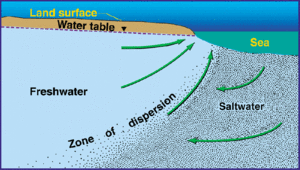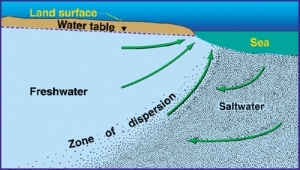Effect of climate change and land use change on saltwater intrusion
Contents
- 1 Introduction Figure 1. Schematic representing of the saltwater intrusion. Fresh water is a scarce resource. According to the World Meteorological Organization, only 2.5 percent of the total water volume on the Earth is fresh water and the remainder is saline (Effect of climate change and land use change on saltwater intrusion) . The largest available source of fresh water still lies underground and the availability of surface water has become sparse in many areas in the world. Groundwater is used extensively to supplement available surface water to meet ever increasing water demand in the world. When considering the water resources in areas bordering seas, coastal aquifers are important sources of fresh water.
- 2 Factors affecting the saltwater intrusion
- 3 Effects of climate change
- 4 Effects of land use change
- 5 Further reading
Introduction Figure 1. Schematic representing of the saltwater intrusion. Fresh water is a scarce resource. According to the World Meteorological Organization, only 2.5 percent of the total water volume on the Earth is fresh water and the remainder is saline (Effect of climate change and land use change on saltwater intrusion) . The largest available source of fresh water still lies underground and the availability of surface water has become sparse in many areas in the world. Groundwater is used extensively to supplement available surface water to meet ever increasing water demand in the world. When considering the water resources in areas bordering seas, coastal aquifers are important sources of fresh water.
Since groundwater systems in coastal areas are in contact with saline water, one of the major problems is saltwater intrusion. Saltwater intrusion refers the replacement of fresh water in coastal aquifers by saltwater due to the motion of a saltwater body into the freshwater aquifer (Figure 1). Saltwater intrusion reduces the available fresh groundwater resources in coastal aquifers. At present, many coastal aquifers in the world, especially shallow ones, experience an intensive saltwater intrusion caused by both natural and human-induced processes.
Use of coastal aquifers as operational reservoirs in water resource systems requires the development of tools that facilitate the prediction of the aquifer behavior under different conditions. Quantitative understanding of the patterns of movement and mixing between freshwater and saltwater, as well as the factors that influence these processes, are necessary to manage the coastal groundwater resources. It is imperative to understand these processes when planning salinity management strategies. Hence, the studies on saltwater intrusion have become necessary in designing and planning of groundwater systems in coastal areas.
Factors affecting the saltwater intrusion
In nature, the freshwater-saltwater interface (Figure 1) seldom remains stationary. Large scale recharge into the aquifer as well as withdrawals from it, result in the movement of the freshwater-saltwater interface from one position to another. The movement will advance or retreat, depending on whether the freshwater flow through the aquifer is decreased or increased. Therefore, change in groundwater recharge directly affects the saltwater intrusion. Subsequently, saltwater intrusion of coastal aquifers will accelerate due to the reduction of groundwater recharge. This could mean a reduction of fresh groundwater resources in coastal aquifers. Even though groundwater recharge is the major source of freshwater across most aquifers, particularly in arid and semi-arid regions, there has been very little research on the potential effects of groundwater recharge on saltwater intrusion and factors affecting the saltwater intrusion.
Changes in climatic variables, such as precipitation and temperature, and the land-use change can significantly alter groundwater recharge rates for major aquifer systems and thus affect the saltwater intrusion. Under such circumstances it is important to study the problem of saltwater intrusion and estimate the saltwater intrusion due to changes in recharge or discharge of groundwater and related activities such as climate (Climate change) changes and change in land-use pattern.
Effects of climate change
Climate change is likely to have profound effects on the hydrologic cycle through altered precipitation, evapotranspiration, and soil moisture patterns. Atmospheric carbon dioxide levels have continually increased since the Industrial Revolution. The continuation of this phenomenon may significantly alter global and local climate characteristics, including temperature and precipitation. Extra precipitation will be unequally distributed around the globe. Some parts of the world may experience significant reductions in precipitation, or major alterations in the timing of wet and dry seasons. These changes will lead to altered groundwater recharge in watershed areas, which will change the groundwater flow to coastal regions and thus the rate of saltwater intrusion in coastal aquifers. Therefore, information on the local or regional impacts of climate change on hydrological processes and coastal water resources is becoming more important.
Effects of land use change
 Figure 2. Groundwater flow patterns and the zone of dispersion in an idealized, homogeneous coastal aquifer. (Source: USGS)
Figure 2. Groundwater flow patterns and the zone of dispersion in an idealized, homogeneous coastal aquifer. (Source: USGS) Changing land use and land management practices can also alter the hydrological system. Land-use change has a direct effect on hydrologic processes through its link with the evapotranspiration regime on one hand and the sometimes extreme change in surface runoff on the other hand. Hence, land use also plays a main role in assessing groundwater resources. Precipitation is the primary source of groundwater and varies both temporally and spatially. For most hydrological applications, it is appropriate to assume that precipitation is independent of vegetation type, and evapotranspiration and surface runoff are closely linked with land-cover characteristics. A large number of land-use impact studies on water resources have been carried out for [[watershed]s] with a focus on water scarcity, flood, erosion, and water management.
The combined effect of climate (Climate change) and land-use changes shows that deforestation (change of land use from forests to agricultural lands) leads to increased groundwater recharge in arid areas, because deforestation leads to reduced evapotranspiration even though it favors runoff.
Further reading
- IPCC. 2001. Climate Change 2001: The Scientific Basis. Contributions of Working Group I to the Third Assessment Report of the Intergovernmental Panel on Climate Change. Houghton, J.T., Ding, Y., Griggs, D.J., Noguer, M., van der Linden, P.J., Dai, X., Maskell, K., and Johnson, C.A., (Eds), Cambridge University Press: Cambridge, UK. ISBN: 0521014956
- Mahesha, A. and Nagaraja, S.H. 1996. Effect of natural recharge on sea water intrusion in coastal aquifers, Journal of Hydrology, 174:211-220.
- Ranjan, S.P., Kazama, S. and Sawamoto, M. 2006. Effects of climate and land use changes on groundwater resources in coastal aquifers, Journal of Environmental Management, 80(1):25-35.
- Ranjan, S.P., Kazama, S. and Sawamoto, M. 2006. Climate change and fresh groundwater resource in coastal regions. Global Environmental Change, 16:388-399.
